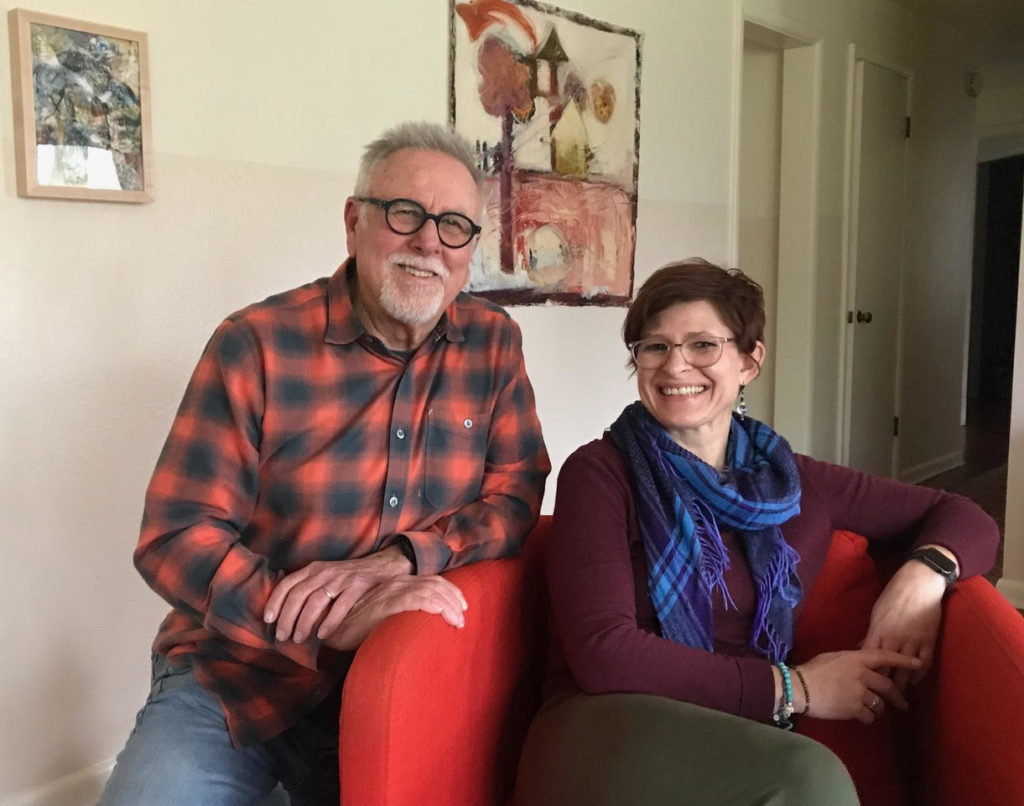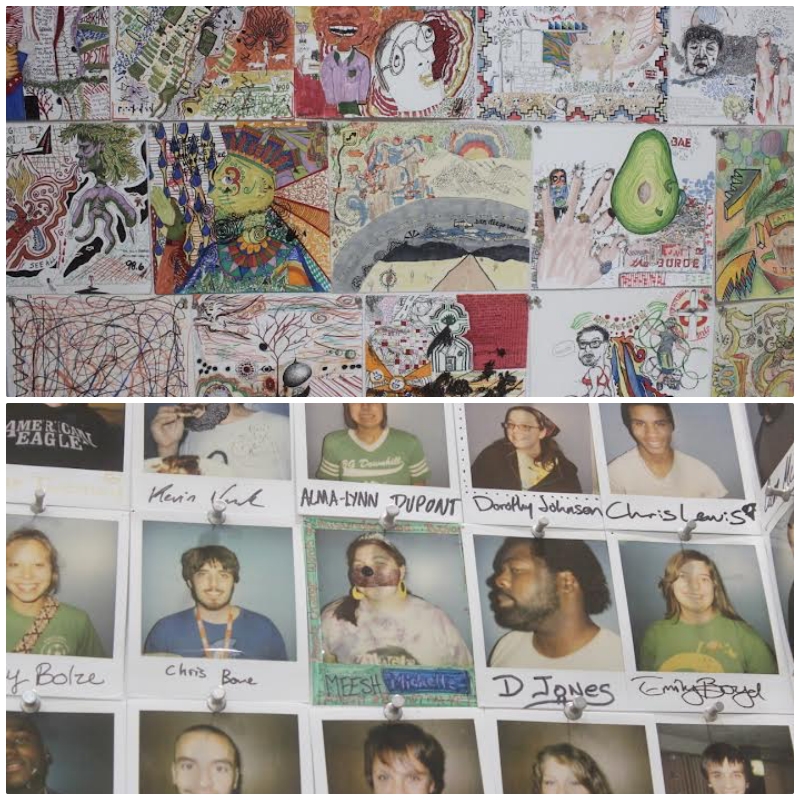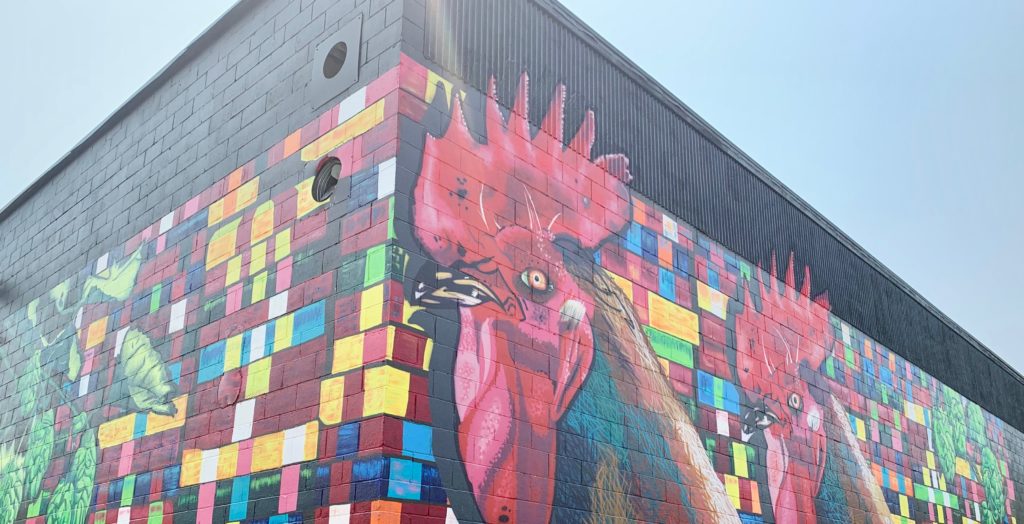By DAVID DUPONT
BG Independent News
Gordon Ricketts was all set to go to the Lesser Antilles to teach at-risk youth small appliance repair as a Peace Corps volunteer.
Then he was offered a one year position as the art instructor at the Chapman Learning Community.
He arranged to delay his Peace Corps stint for a year. “They offered me the job at Chapman for one year. … That one year turned into 23 years.”
Ricketts didn’t get to the Lesser Antilles. He retired at the end of 2021 as a teaching professor in the BGSU School of Art.
In those years, Ricketts has traveled many other places, often with students in tow.
That’s include Ghana, Peru, the Navajo nation, as well as Chicago, the South Bronx, and San Francisco.
Ricketts has also left his mark close to home. He and his students have created murals in Toledo and more recently in Bowling Green.
A painter by training, his own private work has gone by the wayside. “What happened was the Arts Village,” he said. After his stint with Chapman, he was offered the job of directing the Arts Village. “It took my life over.”
He continued: “Painting was a passion for me. It was something I did passionately. I found the Arts Village became my passion and working with students and being a teacher became my passion.”
He no longer has time to paint.

Ricketts, 75, said, he didn’t set out to be a teacher. In fact, he said, he never sought the jobs at BGSU. They fell his way. “I didn’t want them.” But they turned out to be his life.
This was the kind of happenstance that landed him at BGSU in 1998 to study painting in the Master of Fine Arts program.
Ricketts, who grew up in Chula Vista California between San Diego and Tijuana, said his skill as an artist manifested itself early. He was selected as the best artist in his elementary school and chosen to paint in the park.
After high school, he attended community college to study art, but couldn’t manage to get to class. After three semesters he was asked to leave.
Ricketts said he was having fun.
“Surfing and girls,” his wife, Mandy Ricketts, said.
He was a self-described “fuck up” for 20 years. He wasn’t creating art, he said. “I was an alcoholic, so I wasn’t doing a whole lot of any good.” He got sober in his 30s. He did construction for five years, until the economy hit a rough patch. He sold cars. And in his 40s, he decided to go back to college.
“I didn’t go back to be an artist or to be a teacher,” he said. “I went to meet people. I took art courses because it was one of those things I was good at. I certainly didn’t consider myself an artist.”
After getting an associate degree at San Diego City College, he headed north to continue his studies at the San Francisco Art Institute. He just went to visit the school, showed them his portfolio, and was accepted immediately.
Through his friend Debra Babylon, who he had as a teacher in San Diego and was his roommate in San Francisco, he learned about BGSU, where she’d earned her BFA and MFA.
Ricketts said everyone he knew from art school was going on to graduate school.
He did well at BGSU. Early on he had a solo show at the Carroll McCune’s Renaissance Gallery in downtown BG featuring his “doghouse” paintings. They were a statement about the place of artists in society.

As a graduate student, he went on his first major trip. He traveled to Ghana with art colleague Rebecca Skinner Green and ethnomusicologist Steve Cornelius. He went the first time as a student, then got a stipend to help the next two years, and led the trip as a faculty member in 2001. The program ended after the 9-11 attacks.
The impact of those trips is profound, he said. The traveler returns and goes back to life as before, buying groceries, getting gas. “Somewhere along the line I realized my thinking had changed, how I saw the world, and that was because of that trip to Ghana.”
Mandy Ricketts, who has traveled with him, added: “From the time I knew Gordon in early 2000s, every break the man was gone. Every time there was break. He did it for free. That’s what he did with his breaks – put together trips to take students out of their comfort zones.”
The trips are not easy, on the students or Ricketts, she said. “They pushed him physically and certainly emotionally.”
Through Bill Thompson, director of the United Christian Fellowship, Ricketts started what would be a long relationship with the Navajo Nation in New Mexico.
These annual trips, which started in 2001, and were disrupted in 2020. (Read related story) “We weren’t there to do service,” Ricketts said. “It’s not a mission trip.”
In those participants come away feeling good about having done good. There’s a sense that they are somehow above those they help on the social hierarchy.
“It’s more about reciprocity,” Mandy Ricketts said.
“We did stuff, but the trip was never about doing service work,” Ricketts said. “We wanted to meet them and we wanted them to meet us, too”
He continued: “The real thing is the students are removed from everything they know,” Ricketts said.
They drive through the night, and they wake up in the morning in another world. Their phones are stashed in a box, he said. Staying connected to their boyfriends or girlfriends or their mothers “would be dumb,” he said. “We’re out here trying to learn something … There is a certain degree of discomfort because you’re in a place that’s so far removed from what you’re accustomed to.”
There are no showers – water is a limited resource on the reservation. The food is strange. They participate in the butchering of the sheep that they then eat.
The same philosophy informs other trips whether to the South Bronx or Peru.
These students get from the trips the same things Ricketts has gotten. “They get a better idea of how they fit in the world and how they fit in their own skin.”
Ricketts worked to keep them as affordable as possible, doing the planning and keeping everything bare bones.
The university, though, now wants any trips to go through a travel agent, and that jacks up the price.
He’s also developed long-term friendships with people he’s met on the trips, such as Navajo artist Wayne Wilson and the late master drummer Bernard Woma, from Ghana, both of whom later visited BGSU to share their wisdom.

Working with the community also informs Ricketts work as a muralist.
He was approached in 2010 by School of Art administrators about helping to bring in an ethnic artist for a residency. He knew right away who he wanted.
He’d met Peruvian artist and activist Mario Torero in San Diego, where the artist was the driving force behind Chicano Park, now a national historic landmark.
Ricketts already had a relationship with the Sofia Quintero Art and Cultural Center in Toledo.
He and Torero met with residents of the area, attended the Spanish mass at Saints Peter and Paul and went to school to explain what their ideas were.
With community support, they enlisted students from BGSU and the University of Toledo and others to create the first murals, which have since been destroyed by the Broadway Street overpass work.
The project became a course, and after five years, Ricketts took over the program.
The students are involved from the design through completion.
It is a grind, Mandy Ricketts said. Work days start early and extend into the night, when the design is projected onto the surface to prepare it for painting.
[Related: BGSU students paint murals to animate Toledo neighborhoods]
“I like the opportunity to interact with the community,” Ricketts said. “That’s the fun part and that’s something students don’t get to do in the School of Art. They don’t get to do community type things. Most artists work solo or with a partner. This is a chance to work in a group.”
For the many arts education students who participate this gives them a useful skill. Often, Ricketts said, they’re asked to paint murals in the school gymnasium or elsewhere when they get hired.
In the past several years, Ricketts has been commissioned to create murals in Bowling Green. The city has until recently been “resistant” to mural work, but now a number have appeared created by several artists.
Ricketts’ most recent commission was for one inside Juniper Brewing. He also did one in the alley on the east side of the 100 block of South Main and the large murals that cover north and west walls of Arlyn’s Good Beer. His first mural work in BG was refreshing the Great Black Swamp mural first created by Adrian Tio.
These he designs, but still hires students and former students to do the painting.
Retirement will offer Ricketts a break. Mandy Ricketts said her husband is not one to take it easy. He’s on campus early in the morning even if his first class isn’t until noon and often working late.
His wanderlust remains. He wants to visit the four states he hasn’t gone to yet – North and South Dakota, Montana, and Alaska, and not just to pass through but to stay for a few weeks. There’s a ceramics workshop in Peru that offers fellowships where he’s interested in working.
And Ricketts is still wants to paint the town. He’s working with artist Carrie Day on a project to paint a mural on the outside north wall of Howard’s Club H.

